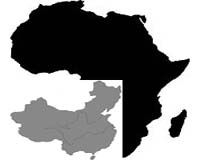 |
Caracas (AFP) April 22, 2010 Companies from around the world have flocked to Venezuela's Orinoco Belt over the past three years to work on extracting heavy and ultra-heavy oil -- an expensive process made worthwhile with oil prices rising. These companies want some of the action even after leftist President Hugo Chavez changed investment rules in 2007 and mandated that the state oil consortium, Petroleos de Venezuela (PDVSA), maintain a minimum 60-percent stake in all Orinoco projects. Currently some 30 companies from more than 20 different countries are operating in the Orinoco Belt, a 55,314 square kilometer (21,360 square mile) oil reserve in the Orinoco River area. For years experts believed that it was too expensive to extract and refine the heavy and extra-heavy oil in the area. But the drop in light oil reserves and the increase in global oil prices -- currently around 80 dollars a barrel, against 20 dollars a barrel in the 1990s -- has revived the interest among foreign investors. Some oil companies, like the US-based ConocoPhilips and Exxon Mobil, left Venezuela in a huff after the Chavez administration nationalized their assets in 2007. But plenty of other companies moved in to replace them. France's Total, Norway's Statoil, Italy's Eny, China's Sinupec, British Petroleum and US-based Chevron have all accepted the new rules of the game. Access to the projects can be currently obtained in two ways: agreements between governments, as was the case with countries friendly to the Chavez administration like China, Russia and Belarus, and public tenders. Currently a consortium of Russian companies will drill in four blocs on the Orinoco Belt, while Eni will exploit one bloc, and Petrovietnam will exploit another. Chevron and Spain's Repsol in February obtained permission to work in two blocs in the Carabobo area, in partnership with Indian, Malaysian and Japanese companies. And Caracas is finalizing a deal to let Chinese companies exploit another bloc. According to Energy and Oil Minister Rafael Ramirez, around 120 billion dollars will be invested in the Orinoco Belt between now and 2017. "The Orinoco Belt will be Venezuela's future oil region, which will provide the barrels of oil into the future, and which will help us reach our goal of producing 6.862 million barrels (a day) by 2021," Ramirez said recently. Venezuela produces 3.06 million barrels of oil a day, according to government figures, though the Organization of Petroleum Exporting Countries (OPEC) pegs Venezuelan production at 2.35 million barrels of oil a day. Currently PDVSA's production, along with its foreign partners, in the Orinoco belt is of 954,000 barrels a day of extra-heavy oil, according to government figures. At the same time, PDVSA is working with companies from Vietnam, China, Italy, France, South Africa, Portugal, Belarus and Russia, among others, to certify its oil reserves. Venezuelan reserves jumped 23 percent in late 2009 to 211,173 million barrels, according to government figures, making Venezuela the country with the second largest crude reserves after Saudi Arabia. Most of this jump was including the heavy and extra-heavy oil from the Orinoco Belt. With the inevitable decrease of light oil deposits and the increase in oil prices, the focus on heavy oil makes financial sense. "The big companies are focusing their resources on regions like Venezuela, because the future is here," said Total vice-president Jean-Jacques Mosconi said recently.
Share This Article With Planet Earth
Related Links Powering The World in the 21st Century at Energy-Daily.com
 Africa should harness Chinese oil-interest: analyst
Africa should harness Chinese oil-interest: analystCape Town (AFP) March 16, 2010 African states should harness Chinese interest as Beijing's demand for commodities drives growth on the continent and fuels capital investments, an energy conference heard on Tuesday. China's investment model in Africa, characterised by long-term capital concessional financing, was a developmental "no-brainer," Martyn Davies, head of the Frontier Advisory firm, told the Oil and Gas Africa ex ... read more |
|
| The content herein, unless otherwise known to be public domain, are Copyright 1995-2010 - SpaceDaily. AFP and UPI Wire Stories are copyright Agence France-Presse and United Press International. ESA Portal Reports are copyright European Space Agency. All NASA sourced material is public domain. Additional copyrights may apply in whole or part to other bona fide parties. Advertising does not imply endorsement,agreement or approval of any opinions, statements or information provided by SpaceDaily on any Web page published or hosted by SpaceDaily. Privacy Statement |